Right now, you’re probably doing one of three things: checking how long this post is, looking for social signals like comments or shares, or wondering if the person who sent you this link knows what they’re talking about.
Plot twist: all three of those behaviors are social proof in action. And we haven’t even officially started yet.
So what is social proof, exactly? Social proof is when people look to others before deciding. In marketing, it means using signals like reviews, endorsements, usage numbers, or badges to help someone choose with confidence. It’s that invisible force that just influenced how you approached this very article.
Think about it: you choose the busy restaurant over the empty one, trust products with thousands of reviews, and feel more confident when others agree with you. Online, it shows up as stars beside a CTA, “Trusted by 10,000 teams” on pricing, or a G2 badge on the homepage.
Here’s the thing: social proof has probably influenced more of your decisions than you realize. In this guide, we’ll break down how it works, explore the six types you encounter daily, and show you how brands use it to influence choices.
So, let’s dive right in!
Social proof is a psychological shortcut. When we’re unsure, we look at what other people choose and treat that as a safe bet. In marketing, this shows up as reviews, endorsements, usage numbers, badges, and real customer stories that lower the risk of saying yes.
Psychology calls this informational social influence. We copy credible signals from the group when the situation feels uncertain. That is why a page with recent reviews and recognisable badges feels easier to trust than a page with none.
👉 Think about it like this: We assume that surrounding people possess more knowledge about the situation. So instead of researching every option, we look around and think, “What is everyone else doing?”
The psychologist Robert Cialdini first named this concept in his 1984 book “Influence.” But humans have been using social proof for thousands of years. It’s why we:
In marketing, social proof is any sign that a product or service has real users. Reviews, star ratings, testimonials, user counts – these all are part of social proof.
For most of human history, going against the group could literally get you killed. If everyone in your tribe was running from something, you didn’t stop to analyze the threat or face the consequences. You joined them.
That’s because, as social creatures, humans are constantly looking to others for cues on how to behave. This instinct served us well when we lived in small groups where everyone knew everyone. But now we apply the same logic to strangers on the internet.
As a result, decision making becomes credible and validated through the behavior of others. We see 1,000 five-star reviews and think, “1,000 people can’t be wrong, right?”
Here’s where things get interesting. The internet has taken principle of social proof in a whole new direction, one that would blow the minds of our ancestors. Let’s see how:
Before the internet, our social proof came from:
Now our social proof comes from:
Social proof in marketing means showing evidence that other people trust and use your product. Think reviews, star ratings, “Trusted by 10,000 teams,” expert quotes, and badges placed near the action to lower hesitation.
Social proof works only when it shows up at the exact moment of doubt. Below are the best places you can add it across your site and campaigns, with quick ideas you can ship today.
Your final landing page is where doubt is highest and attention is shortest. People scan for proof near the action and decide in seconds. That’s why it is important to put proof in the hero section (where eyes land first).
There are many ways of adding social proof to your product or category pages:
Make it concrete and current. Include the review count, the date of the most recent review, or “Verified buyer” labels. On mobile, keep the proof above the fold and readable without zoom.
For reference, check Todoist’s latest landing page. They have very clearly added budges that gives the user confidence & helps them stay on the landing page longer:
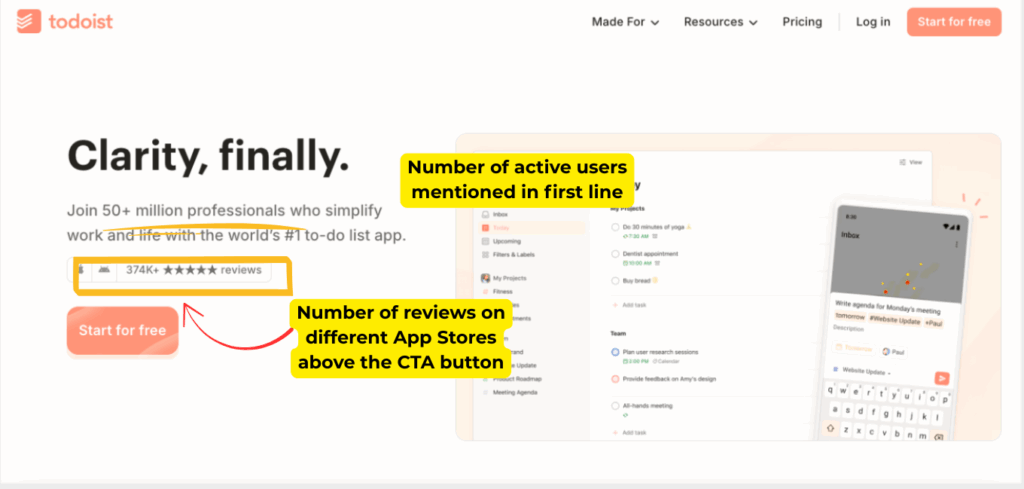
Once the user has made it through the landing page, it is the pricing or signup pages where user feels a sense of “risk” and raises questions like: “Will this work for my team?” “Is it safe to pay?” At this stage, social proof lowers friction.
Place “Trusted by x teams” near the plan selectors. You can even add security and compliance badges close to the payment fields. At this stage, it is important to only show badges that will actually matter to the buyer. You only have limited space to get their attention.
For reference, check Clickup’s pricing page. They have multiple signals that help the user overcome that feeling of “risk” and eventually move ahead in the buying journey.
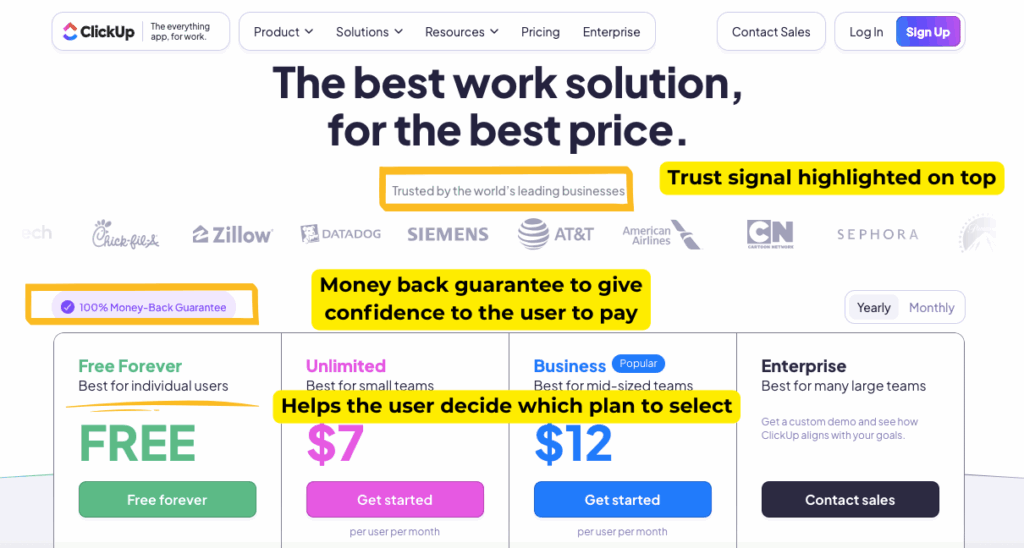
Ads have almost no time to persuade the final customer. That’s why it becomes essential to let the social proof carry the message and make the benefit very obvious at the first glance.
Lead with a customer quote as the headline or first line. If the format allows, overlay “Used by …” or a star rating. Before/after visuals work when the benefit is visible in one frame.
Make it legible on small screens. Keep the proof line under 8–10 words. Add the fuller quote or source in the caption or landing page hero to complete the story.
For reference, I remember this Meta ad by HeyOrca (a social media management tool). They have used customer testimonials to catch the interest of relevant audience.
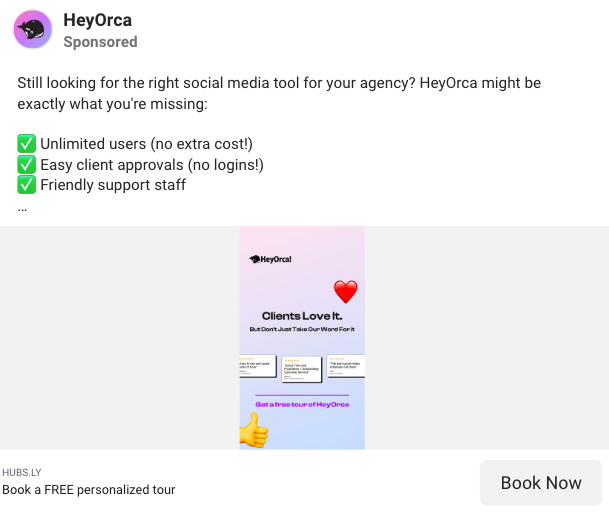
Email and social are perfect for fresh, lightweight proof. They nudge people who already know you and just need a reason to act now.
You can bring it in practice by featuring a recent review, a short case tile, or a quick UGC clip and linking straight to the next step. Usage counters like “1,247 signed up this week” work well when they are real and update often. However, it is important to avoid spammy stacks.
Online choices are noisy and fast. You have limited time, limited attention, and far too many tabs open. Social proof reduces that mental load. A 4.8 rating from 50,000 users feels more reliable than a perfect 5.0 from three reviews. Your brain picks the option that seems vetted by others and moves on.
The modern web amplifies these cues. Counters update in real time. Friends’ activity shows up in feeds. Marketplaces surface what is trending. None of this guarantees quality, but it makes the path to a decision feel safer.
Let’s check out some numbers and social proof statistics:
Social proof is evidence that reduces uncertainty. Showing off is noise that inflates ego. One helps a hesitant buyer decide. The other distracts.
A simple test: does this signal come from outside your team, is it specific and verifiable, and does it help a reader take the next step? If yes, it’s proof. If not, it’s just bragging.
When it comes to social proof: it’s not one-size-fits-all.
A recommendation from your best friend hits differently than a review from a stranger, right? But that not entirely correct. The stranger’s review might actually carry more weight if they’re a recognized expert.
So let’s break down the different types of social proof you encounter every day:
This is when someone with authority backs your product. Think subject-matter specialists, certified professionals, or recognised analysts whose domain matches your product. It works because we have this weird human quirk where we assume successful people must know something we don’t. (Even when that success has nothing to do with the product they’re promoting.)
Signals: “Recommended by…”, expert quotes, author bios with credentials, analyst reports.
Works best: Ads, landing pages, and long-form content that needs credibility.
Example: “Recommended by board-certified dermatologists.”
But here’s the trick: the expert needs to actually be relevant. When a basketball player endorses athletic shoes, it makes sense. When that same player starts giving financial advice… well, you get the idea.
Best social proofing examples you’ll come across will include customer reviews and testimonials. That’s because real customers make outcomes feel achievable. This is the most versatile type of social proof and often the highest converting.
Signals: Star ratings, review counts, testimonials, UGC photos, “Verified buyer”.
Works best: Product pages and near CTAs.
Example: “4.8/5 from 1,264 reviews” beside the “Add to cart” button.
👉 Here’s what separates good user social proof from great: specificity.
“This changed my life!” sounds nice but tells you nothing.
“I went from working 12-hour days to finishing everything by 5 PM using this system” – now that’s something you can picture yourself achieving.
“Over 1 million downloads!” “Join 50,000+ subscribers!” “Trusted by 10,000+ businesses!”
Sound familiar? This is the numbers game. When lots of people choose something, our brains go: “Well, they can’t ALL be wrong, right?” (Spoiler alert: Sometimes they can be. But our evolutionary wiring doesn’t care about that detail.)
This type of social proof works because it removes the burden of being the first to try something. Netflix’s “trending now” section? Pure wisdom of crowds. Here, you’re not just watching a show – you’re joining a movement.
Signals: “1M+ downloads”, “#1 in Productivity”, “Trending now”, best-seller tags.
Works best: Category pages, app stores, homepage rails.
Example: “Chosen by 10,000 teams this month.”
This type of social proof comes as a bit sneaky. It’s when your social media shows you what your friends are buying, where they’re eating, what they’re reading, which events they’re attending.
We trust people we know, plus we want to fit in. For example: If everyone in your friend group suddenly starts talking about that new Korean skincare routine, you’re probably going to Google it.
Social media platforms have made this type of social proof incredibly powerful. Your “friends” now include people you met once at a party three years ago, but you still subconsciously treat their activity as recommendations from your inner circle.
Signals: “3 teammates already joined”, “Your friends are listening to…”, invite banners.
Works best: Product invites, onboarding, and social feeds.
Example: “Two colleagues use this workspace” on a signup screen.
This is third-party validation from organizations that supposedly know what they’re talking about. It works because it removes some of the risk from your decision. If the Better Business Bureau or some industry association says this company is legit, you can trust it.
Signals: Security and compliance badges, awards, marketplace or analyst badges.
Works best: Pricing, checkout, enterprise pages.
Example: G2 Leader + ISO badge near plan selectors.
But here’s the plot twist! The most convincing social proof usually combines several of these types.
A skincare product with dermatologist recommendations (expert) + thousands of five-star reviews (user) + “trusted by 500,000+ customers” (crowds) + your friend posting about it (social circle) + industry awards (certification)? That’s not just social proof – that’s social proof on steroids.
But remember what we talked about earlier: authenticity trumps everything. One genuine testimonial from someone who actually used and loved your product beats a dozen fake reviews or bought endorsements.
The real question isn’t which type of social proof is strongest. It’s which type your specific audience trusts most for the specific decision they’re trying to make.
Big brands don’t just pile on badges. They place the right signal where a decision happens. Below, notice how each example pairs a social proof in marketing type with the action on that screen.
You’ve probably interacted with these examples without even realizing it. That’s the beauty (and slight creepiness) of well-executed social proof – it influences your decisions without you consciously noticing.
Amazon didn’t accidentally become the “everything store.” Their review system is social proof perfection. Not just the star ratings, but the details: “Verified Purchase” badges, “Helpful” votes on reviews, even the photos customers upload.
But here’s the clever part: Amazon shows you reviews from people who bought similar items, reviews from people in your area, and reviews that mention your specific concerns. It’s like having a conversation with thousands of previous customers.
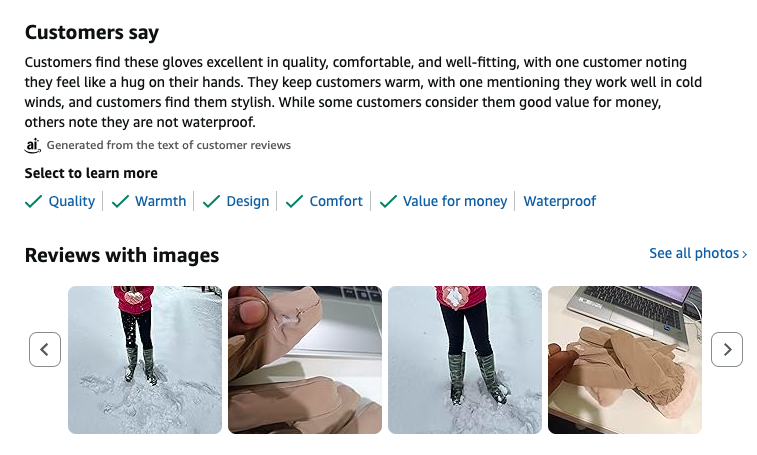
“Trending Now,” “Popular on Netflix,” “Others also watched” – these terms used by are a type of social proof. They’re not just showing you what’s popular; they’re showing you what people like you are watching.
That little “97% match” rating? That’s not just algorithm magic. It’s social proof disguised as personalization. Netflix is essentially saying, “People with your viewing habits loved this.”
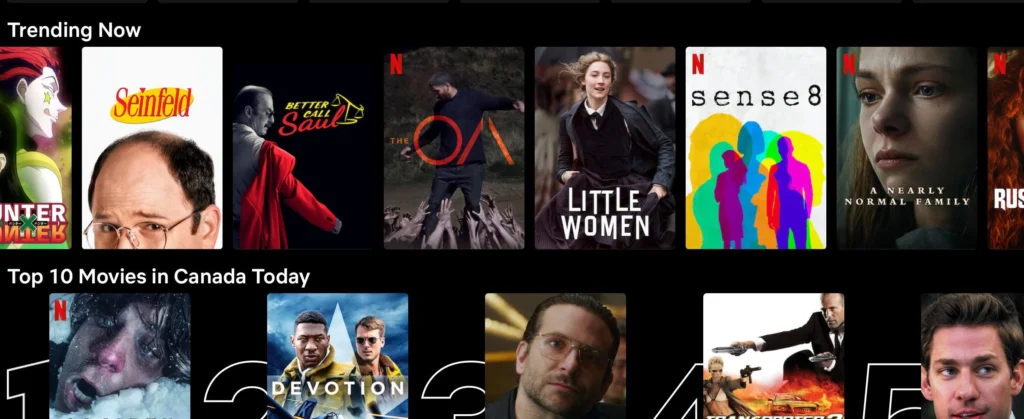
For Booking.com, live notices like “Booked X times today” and “Y people viewing” mix Crowd proof with gentle urgency to push a quicker decision.
Booking.com has weaponized urgency and social proof. They’re not just showing you available hotels; they’re showing you a live stream of other people’s booking decisions. It’s like standing in that restaurant line we talked about earlier, but digitally.
“Your friends are listening to…” “Popular with fans of [artist you like]…” “Discover Weekly based on your taste…”
Spotify takes your music preferences and connects them to social proof. They’re not just recommending songs; they’re showing you what your extended musical family is enjoying. It’s social proof that feels personal rather than pushy. Friend activity and playlist follower counts blend Friends proof with Crowd proof, making choices feel safe and familiar.
PS: Did you know more than 2 billion music discoveries happen on Spotify every day?
Social proof helps only when it builds real confidence. It backfires when the signal is negative, noisy, fake, misaligned, stale, or hard to verify. Use it to reduce doubt, not to decorate the page.
You know those products with 500 five-star reviews that all sound like they were written by the same person? Yeah, those exist. And they’re everywhere.
Red flags to watch for:
Example: In July 2025, Amazon said it secured its largest-ever legal win against a global fake-review network (75+ websites seized) and noted it proactively blocked 275M suspected fake reviews in 2024. This is also a reminder that review abuse is industrial, not occasional.
Constant “Only 2 left” or “Selling out fast” feels gimmicky. If the claim is not real, users stop believing other signals too.
The key is asking yourself: Does this urgency make logical sense? If a product has been “almost sold out” for weeks, something’s fishy.
Not all influencer endorsements are genuine. Some are paid partnerships (which should be disclosed), others are just people desperate for free stuff saying whatever brands want to hear.
Look for: Authentic usage over time, honest pros and cons, disclosure of partnerships, and recommendations that fit their actual lifestyle.
Social proof can create bubbles where everyone’s making the same decision, even if it’s not the best one. Think housing bubbles, investment crazes, or fashion trends that make you look back and think, “What was I thinking?”
The cure? Diversify your social proof sources. Don’t just look at what people in your circle are doing. Seek out different perspectives and expert opinions.
If you’re building something – a business, a personal brand, a community – here’s how to leverage social proof ethically:
You don’t need thousands of testimonials. Start with one genuine success story. Then another. Quality beats quantity every time.
One detailed case study about how your product actually helped someone solve a real problem is worth more than 50 generic “great product!” reviews.
The best social proof happens naturally when people are genuinely excited about something. Your job is to make it easy for them to share that excitement.
Follow up with customers after they’ve had time to use your product. Ask specific questions about their experience. Then ask if you can share their story (with their permission, obviously).
If reviews are incentivized, say so. If testimonials are from friends, mention it. If numbers are from a specific time period, include that context.
Transparency builds trust, and trust is the foundation of all effective social proof.
Don’t just highlight the wins. Show the journey. The challenges, the process, the real results (not just the highlight reel).
People connect with authentic stories, not perfect ones. A testimonial that mentions initial skepticism but then describes genuine results is more convincing than pure enthusiasm.
Add social proof with a clear goal, then track the nearest action. Look for quick directional gains first. If the signal is real and well placed, you should see faster clicks and fewer stalls.
| KPI | Where to watch | What a lift means | Red flags |
|---|---|---|---|
| Add-to-cart rate | Product pages | Proof eased hesitation near the button | More clicks on reviews than on the CTA |
| Checkout conversion | Pricing/checkout | Trust improved at pay step | More exits on payment fields |
| CTR | Ads and emails | Proof made the message clearer | Clicks rise, but CPA worsens |
| Form completion | Signup/demo | Credibility reduced friction | Time on form increases without completions |
| Time on page | Product/pricing | Visitors are engaging with proof | Long reads but low clicks to CTA |
| Scroll depth | Long pages | People reach the CTA more often | Stops above the proof cluster |
Interpreting results: if CTR rises and CPA falls, keep the placement and refresh the example monthly. If CTR rises but CPA worsens, the proof may attract the wrong clicks. Tighten the copy and test a different type.
PS: If you’re growing a brand from scratch, this guide on how to market a small business will definitely give you an insight to implement.
Use this checklist as a quick reference to implement, audit, and refine your social proof strategy:
| Category | Checklist Item |
|---|---|
| Foundation | Identify which types of social proof (expert, user, crowd, friend, certification) your audience trusts most. |
| Ensure proof is visible near primary calls to action (signup, buy, download). | |
| Verify all testimonials, reviews, and claims are authentic and credible. | |
| Content & Placement | On product/landing pages: include ratings, short reviews, “best seller” / “trending” tags. |
| On pricing/checkout: show trust badges, “trusted by X users,” compliance seals. | |
| In ads / creatives: lead with customer quotes, overlay usage stats or reviews. | |
| In emails / social content: share recent reviews, usage highlights, or UGC. | |
| Quality & Recency | Use recent testimonials (last 6–12 months). |
| Use real imagery / videos (not stock). | |
| Display names, dates, and context (e.g. “Verified buyer, June 2025”). | |
| Refresh and rotate proof elements periodically. | |
| Measurement | Track changes in conversion rate (landing, product pages). |
| Monitor CTR uplift in ads / emails with vs without proof. | |
| Check abandonment / drop-off rates at checkout. | |
| Set up a system to collect new reviews / feedback regularly. | |
| Ethics | Avoid fake scarcity or overdone urgency (“only 2 left” gimmicks). |
| Disclose any incentive for reviews or testimonials. | |
| Balance showcasing wins with transparency about challenges. |
Here’s where most businesses mess up: they add social proof to their marketing and then… just hope it works.
Forget vanity metrics. Here’s what you should track when testing social proof:
👉 For detailed list of Meta Ad Metrics, check our guide on 8 Facebook Ads Metrics to Track
You know you need to test social proof, but modern advertising platforms will quickly drown you in data.
Take Meta ads. You’re probably checking basic metrics like reach and clicks, but the platform actually tracks hundreds of data points that could tell you exactly how your social proof performs across different audiences, age groups, and campaign objectives.
The problem? Connecting those dots manually is like trying to solve a 1,000-piece puzzle while blindfolded.
This is where Vaizle AI is changing the game completely. Instead of spending hours digging through Meta’s interface and exporting spreadsheets, you can literally chat with your ad data like you’re texting a friend.
Want to know which testimonials drove the most conversions? Just ask: “How did Ad 1 compare to Ad 2?”
Curious about audience segments? Try: “Which age groups responded best to influencer endorsements versus expert recommendations?”
It’s like having ChatGPT specifically for your Meta ads data. You ask natural questions, get instant insights, and can immediately act on what you learn.
Traditional way: Create split tests → Wait for data → Export to Excel → Spend hours analyzing → Maybe find insights → Test again in two weeks
With Vaizle: Create split tests → Ask your data direct questions in real-time → Get instant insights → Optimize immediately → Scale what works
For example, you could ask: “Show me the conversion rates for ad 1 (with 5-star reviews) versus ad 2 (with before-and-after photos)” and get an immediate answer with visual breakdowns.
Or: “Which social proof elements work best for my retargeting campaigns versus cold audiences?”
The beauty is you’re not just getting numbers – you’re getting actionable intelligence that tells you exactly what to do next.
Here’s the reality: Social proof has been shaping human decisions for thousands of years, and it’s not stopping anytime soon. If anything, it’s getting stronger.
We live in a world with infinite choices and limited time to research every decision. Social proof is our shortcut to making reasonable choices without spending hours researching every option.
The key is using it wisely – both as a consumer and as someone building something.
As a consumer: Look for authentic social proof from diverse sources. Be skeptical of anything that seems too perfect or too urgent. Trust your gut when something feels off.
As a builder: Focus on creating genuine value first, then make it easy for people to share their authentic experiences. Social proof should be a byproduct of doing good work, not a marketing strategy.
Remember that restaurant line from the beginning? Sometimes the crowded restaurant really is better. Sometimes it’s just got better marketing. Your job is learning to tell the difference.
The best social proof isn’t manufactured – it’s earned. And earning it starts with building something worth talking about.
Now go forth and make decisions like the beautifully social creature you are. Just remember to think for yourself once in a while.
Social proof is a psychological phenomenon where people follow the actions of others when making decisions. It’s the reason you choose a busy restaurant over an empty one, trust products with good reviews, and feel confident when friends agree with your choices. Essentially, we look to others for cues on how to behave, especially when we’re uncertain.
The five main types of social proof are: Expert social proof (endorsements from authorities), User social proof (customer reviews and testimonials), Wisdom of crowds (popularity indicators like “1 million users”), Wisdom of friends (recommendations from your social circle), and Certification social proof (awards, badges, and third-party validations). Each type influences decisions differently depending on the context.
Brands use social proof through customer reviews, testimonials, user-generated content, influencer endorsements, and popularity indicators. For example, Amazon shows “Verified Purchase” reviews, Netflix displays “Trending Now” content, and Booking.com shows “23 people viewing this hotel.” These tactics reduce purchase anxiety and encourage conversions by showing that others have made similar choices.
Social proof is powerful because it’s rooted in evolutionary survival instincts. For thousands of years, following the group often meant staying alive. Today, this instinct helps us make quick decisions when faced with too many choices. Our brains use social proof as a mental shortcut, assuming that if many people choose something, it must be the right decision.
Red flags for fake social proof include: reviews posted in clusters within short timeframes, generic language that could apply to any product, reviewers with no purchase history, perfect grammar in all reviews, and manufactured urgency (like “only 2 left” that never changes). Always look for specific details, verified purchases, and authentic language patterns to spot genuine social proof.
Keep it fresh monthly, and set a cadence per asset.
Product pages: rotate review highlights and UGC monthly. Keep top reviews under 90 days old.
Pricing/checkout: re-verify badges, guarantees, and security notes quarterly.
Logos & case studies: audit quarterly; ship at least 2 new case studies/year.
Usage counters (“10,000 users”): automate daily/weekly; if not, update monthly with a “last updated” label.
Expert/creator quotes: relevance and permission check quarterly.
Certifications/awards: update on renewal; do a biannual audit.
Update immediately if: ratings shift by ±0.2 stars, review totals move ±10%, your most-visible review is >90 days old, a badge expires, permissions change, or your pricing/positioning changes.
Rule of thumb: one recent, specific, verifiable signal near the CTA beats a wall of stale ones.
Purva is part of the content team at Vaizle, where she focuses on delivering insightful and engaging content. When not chronically online, you will find her taking long walks, adding another book to her TBR list, or watching rom-coms.